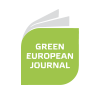(Published in German on 29 October 2020 at 13:20.)
This week I submitted the draft of my report for the Foreign Affairs Committee of the European Parliament on the European “Connectivity Strategy”. With not quite 9000 characters, which is the formal maximum I had to adhere to under Parliament rules, I tried to summarize my ideas on the development of this strategy and to include the results of more than 50 expert discussions I had in the course of my work.
I can imagine that one or the other of my readers may be already tempted to yawn, or considering whether they really want to continue reading. Con-nec-ti-vi-ty? What is that? Well, what sounds really bureaucratic, de facto hides what I think is a very exciting topic.
Connectivity is, to put it simply, the alternative concept to the dangerous practise of political navel gazing. No, we do not want to retreat behind newly raised walls. Connectivity is about how capacity to act is created through cooperation. Or how it is lost through denied or crooked cooperation. In this sense, connectivity is actually a core principle of European integration itself. Time and again it bumps into the limits of national obstinacy, but without the connectivity gene the EU would not exist as a relevant actor. Connectivity policy has always been pursued in the EU’s external relations, too, especially in development cooperation. One dimension has been missing, however: the connecting link between specific connectivity policies and the basic philosophy of connectivity. Here the Connectivity Strategy comes into play, which formulates how the EU and its member states can become a coherent, strategically effective geo-economic and geopolitical actor through the right connectivity initiatives.
The EU Connectivity Strategy was launched just over two years ago and has so far been like a car without wheels. Or a paper tiger. The EU member countries hardly pay any attention to it. Neither do several Directorates-General of the Commission. President Ursula von der Leyen, who took office with the intention of leading a “geopolitical Commission”, has not lost a single sentence on the connectivity strategy, although it is hard to imagine how she would seriously pursue her ambition without it. From some people around her, the subject has been considered boring. And so it was not included in the Commission’s Work Program for 2021.
The priorities that had been set when the Connectivity Strategy was published in 2018 were infrastructure, energy, digitization and people-2-people. The Juncker Commission, just before passing the baton, had organized a major connectivity conference in Brussels last fall, following a proposal I had originally made to them. The response was very good: 1400 participants, including about a quarter from various Asian countries. Japanese Prime Minister Abe was a keynote speaker. And with him, President Juncker signed an agreement on Japan-EU cooperation on connectivity issues. The German government was represented by Minister Altmaier, who promised that Berlin would pursue the topic. In that regard the Federal Government kept its word. The German EU Presidency has provided important impulses for new attention to the connectivity strategy, which unfortunately has not yet met with an adequate response on the 13th floor of the Berlaymont. My report should now offer some further impetus from the European Parliament. If everything goes according to plan, the report, which will certainly gain in scope by then thanks to the amendments that will be proposed by my colleagues, could be adopted by the Committee on Foreign Affairs in December and then hopefully adopted by the European Parliament in a plenary vote in the first quarter of 2021.
My report essentially pursues five objectives.
By reframing the principles of the connectivity strategy, I want to help develop a more convincing narrative than we have had so far. This includes, for example, closely linking the Connectivity Strategy with the EU’s key major projects, such as the European Green Deal and the digital transformation. The various dimensions of our external policy – foreign policy, development cooperation, trade policy, security policy – must also be linked as coherent areas in the Connectivity Strategy. Finally, we need a new language for this endeavor. Whereas China in talking about its own connectivity strategy evokes great imaginations with the term Silk Road, the EU expresses our ambition in rather bureaucratic terms. How can we be surprised that our discourse does little to inspire fantasies and hopes.
Secondly, I want to address some governance issues that need to be resolved if the connectivity strategy is to have legs to walk on. How can cooperation between different Brussels actors replace the bureaucratic turf wars of the past? How can we ensure that the Member States see themselves as co-owners of the strategy and act accordingly? How can business and civil society be integrated? How can international institutions that already exist be used for our connectivity efforts? And, last but not least: How can we ensure that the car = strategy, also has fuel = money to really drive?
Thirdly, it is about setting priorities. I propose six priorities: Green transformation; digitization; People-2-People; trade and international standardization; health; security. I am curious to see if colleagues will agree to this catalogue.
My report is also about connectivity partnerships. It’s about how we are actually implementing the Japanese connectivity partnership. It is about how we bring talks and negotiations with India, South Korea and the ASEAN group of states to a successful conclusion, and then implement them. How we might find common ground with the U.S. and its own Blue Dot Network connectivity program to mobilize private investment for connectivity projects. And how we might be able to work together with China’s Silk Road project. The latter could perhaps be the most difficult task, because the multilateral orientation and the principles of sustainability, transparency, inclusiveness, and rule of law, according to which we operate, are very different from the hegemonic policies of the People’s Republic.
And finally, I propose to extend the scope of the European Connectivity Strategy. Until now, it has only referred to the Eurasian arc from Lisbon to Tokyo. In the future, I believe that our neighboring African continent should have the same priority in connectivity policy as our Asian partners. The EU needs a global connectivity strategy. That does not mean, of course, that we can do everything at once. The extension to Africa, however, is already laid down in the corresponding cooperation agreement with Japan last year.
When I finished my draft report earlier this week, it ran up to 19190 characters. So for the time being I had to delete more than half of my draft text, including numerous concrete proposals. The European Parliament’s practice, however, is that you later in the process you are allowed to enrich your own report with your own amendments. I am curious to see how many amendments there will be in total. If there were fewer than 400 to 500, I would have to say that I have not been able to arouse enough interest. ;-) Then, of course, there is also the question of whether there is support among colleagues for the orientation I am proposing. I am curious


















